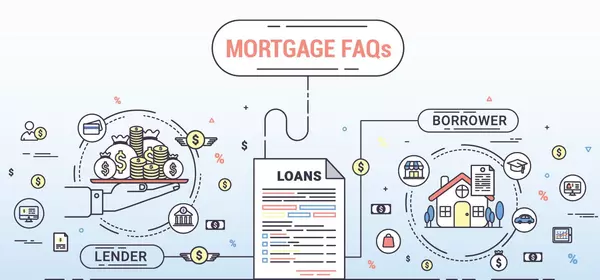Don't Let Student Loan Debt Hold You Back From Your Homebuying Dreams

If you recently graduated from college, chances are you have some student debt. But that doesn’t mean you have to let your debt get in the way of #lifegoals, like buying a house. You might feel like your student loan debt is taking over your life—but it IS possible to qualify for a mortgage, even while paying off your student loan debt.
In fact, over the past few years the mortgage industry has made qualifying guidelines more flexible for borrowers with student loan debt.
If you are looking to purchase a home now or in the future and you have student loan debt, here are some factors that will determine your eligibility.
Factor 1: Your Debt-to-Income Ratio
Debt-to-income ratio (DTI) is calculated by adding up all your monthly debt payments, including expected Housing payment(s), and dividing them by gross monthly income.
So, what is considered a debt payment? Student loans, mortgages, auto loans, credit card debt, and any other installment or revolving debt that you are obligated to repay.
Lenders generally follow something called the “28/36 rule.” This means that no more than 28 percent of your gross income should go to your mortgage payment, property taxes, and insurance. Additionally, your total debt payments, including expected mortgage payment, should be no more than 36 percent of your gross income. However, some loan programs, such as the FHA loan, will qualify borrowers with DTIs of up to 43 percent (or higher in certain circumstances.)
Some borrowers might worry that their student loan debt will increase their debt-to-income so much that they won’t be able to qualify for a mortgage.
So how is student loan debt calculated into your DTI?
Conventional Loans:
If a monthly student loan payment is provided on the credit report, the lender may use that amount for qualifying purposes. If the credit report does not reflect the correct monthly payment, the lender may use the monthly payment that is on the student loan documentation (the most recent student loan statement) to qualify the borrower.
If the credit report does not provide a monthly payment for the student loan, or if the credit report shows $0 as the monthly payment, the lender must determine the qualifying monthly payment using one of the options below:
- If the borrower is on an income-driven payment plan, the lender may obtain student loan documentation to verify the actual monthly payment is $0. The lender may then qualify the borrower with a $0 payment.
- For deferred loans or loans in forbearance, the lender may calculate:
- A payment equal to 1% of the outstanding student loan balance (even if this amount is lower than the actual fully amortizing payment), OR
- A fully amortizing payment using the documented loan repayment terms.
FHA Loans:
For outstanding student loans, regardless of payment status, the FHA will determine the debt by using:
- The payment amount reported on the credit report or the actual documented payment, when the payment amount is above zero OR
- 0.5 percent of the outstanding loan balance, when the monthly payment reported on the borrower’s credit report is zero.
VA Loans:
If student loan debt is deferred for more than 12 months after the mortgage closing date, then the VA will exclude the obligation from the DTI calculation.
If the student loan debt isn’t deferred 12 months post-closing date, the VA will use the higher of:
- Payment on credit report OR
- 5% of outstanding balance divided by 12 months (example: $25,000 student loan balance x 5% = $1,250 divided by 12 months = $104.17 per month is the monthly payment for debt ratio purposes).
However, if the loan file contains a statement from the student loan servicer that reflects the actual loan terms and payment information for each student loan, then the lower payment reported on the credit report could be used.
Need to lower your DTI?
There are a few options to reduce, consolidate or defer your monthly student loan payments to help reduce your debt-to-income ratio:
- Initially reduce your monthly payments by switching to a graduated repayment plan. With a graduated repayment plan, payments start low then rise every two years as your income level rises.
- Request to lengthen your term, which will reduce the amount that you owe each month. You will pay more interest in the long run but will reduce your debt-to-income ratio in the meantime.
- Consolidate different student loans at a lower interest rate. This will reduce your payments and package them together in one convenient monthly payment.
Of course, as mentioned earlier, your payment will factor into your DTI differently, depending on your specific loan program so it’s probably best to speak with a loan officer before doing any of these three things.
Factor 2: Your Credit Score
There is good news for those who pay their student loans on time each month—you’re building a strong credit profile. Here’s a tip: set up auto payments to ensure you’re never missing a payment!
Borrowers with better credit scores can qualify for lower interest rates, which means they’ll be eligible to qualify for lower monthly payments. Unlike credit card debt, student loan debt is an installment loan in which you are required to pay a fixed amount each month. Owning a large amount in an installment debt won’t hurt your credit score like a large amount of credit card debt would.
So, pay your loan on time each month to help build your credit profile.
Factor 3: Your income and down payment
If your debt-to-loan ratio is too high, you could offset that ratio by saving for a large down payment. This will reduce the amount you have to finance and will give you a lower monthly payment, changing your debt-to-income ratio.
If you’re unable to save for a down payment, talk to your loan officer about any grants or down payment assistant programs that you might be eligible for.
A higher income will also help offset your DTI—so consider negotiating for a raise or starting a side-hustle.
So, what’s the bottom line? Yes, it could be more challenging to qualify for a mortgage with student loan debt, but it isn’t impossible. It’s important to know where you stand and speak with a qualified mortgage professional who can help guide you in the right direction.
Sources:
https://www.hud.gov
https://benefits.va.gov/
https://singlefamily.fanniemae.com/
Content provided by TowneBank Mortgage for informational purposes only. The information contained herein (including but not limited to any description of lending programs and products, eligibility criteria, interest rates, fees and all other loan terms) is subject to change without notice. This is not a commitment to lend. TowneBank Mortgage NMLS# # 512138. Equal Housing Lender
Categories
Recent Posts










